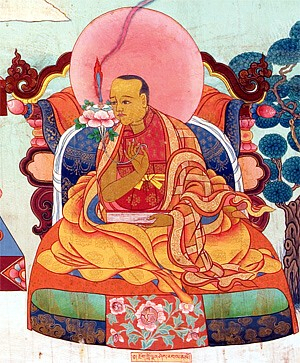Ngok Loden Sherab
Ngok Loden Sherab or Ngok Lotsawa Loden Sherab (Tibetan: རྔོག་ལོ་ཙཱ་བ་བློ་ལྡན་ཤེས་རབ, Wylie: rngog lo ts'a ba blo ldan shes rab) (1059–1109) was one of the most renowned translators in Tibetan history.
For the first seventeen years of his life he was tutored by his uncle Ngok Legpe Sherab, who had been one of the three main disciples of Atiśa Dīpaṃkara.[1]
Later, he travelled to India with Tsen Khawoche and others to study with great Indian masters. He studied with many Indian panditas for seventeen years and then returned to Tibet in 1092 C.E., and became one of the most important Tibetan translators.[2]
He translated Maitreya’s Uttaratantra Shastra and Asanga’s commentary with the Kashmiri pandita Sajjana, as well as Vasubandhu’s commentary on the Dharmadharmata-vibhanga.[3]
"With Bhavyaraja, he translated Prajnakaragupta’s commentary on Dharmakirti’s Pramanavarttika. His many other translations and revisions include the Abhisamayalankara and commentaries by Vimuktisena and Prajñākaramati; Dignaga’s Prajnaparamita-samgraha karika with Triratnadasa’s commentary; and Dharmakirti’s treatises, Pramanavinishchaya and Nyayabindu."[3]
He also revised the translation of the Bodhicharyavatara and composed a commentary on it.[3]
Notes
- ↑
 Ngok Lotsāwa Loden Sherab, Treasury of Lives
Ngok Lotsāwa Loden Sherab, Treasury of Lives
- ↑
 Ngok_Lotsawa_Loden_Sherab, Rangjung Yeshe Wiki
Ngok_Lotsawa_Loden_Sherab, Rangjung Yeshe Wiki
- ↑ 3.0 3.1 3.2
 Ngok Loden Sherab, Rigpa Shedra Wiki
Ngok Loden Sherab, Rigpa Shedra Wiki
Further reading
- Ralf Kramer (2007), The Great Tibetan Translator: Life and Works of rNgog Blo ldan Shes rab (1059-1109), München: Indus Verlag
 Ngok Lotsāwa Loden Sherab, Treasury of Lives
Ngok Lotsāwa Loden Sherab, Treasury of Lives
 Ngok_Lotsawa_Loden_Sherab, Rangjung Yeshe Wiki
Ngok_Lotsawa_Loden_Sherab, Rangjung Yeshe Wiki Ngok Loden Sherab, Rigpa Shedra Wiki
Ngok Loden Sherab, Rigpa Shedra Wiki
